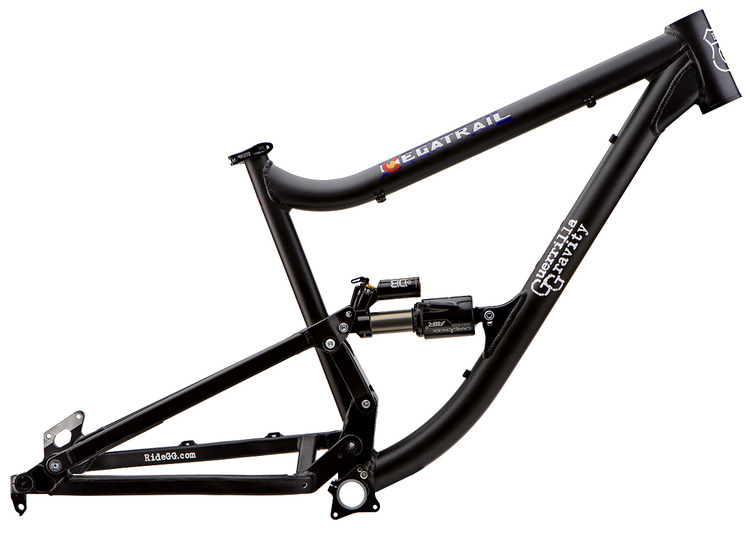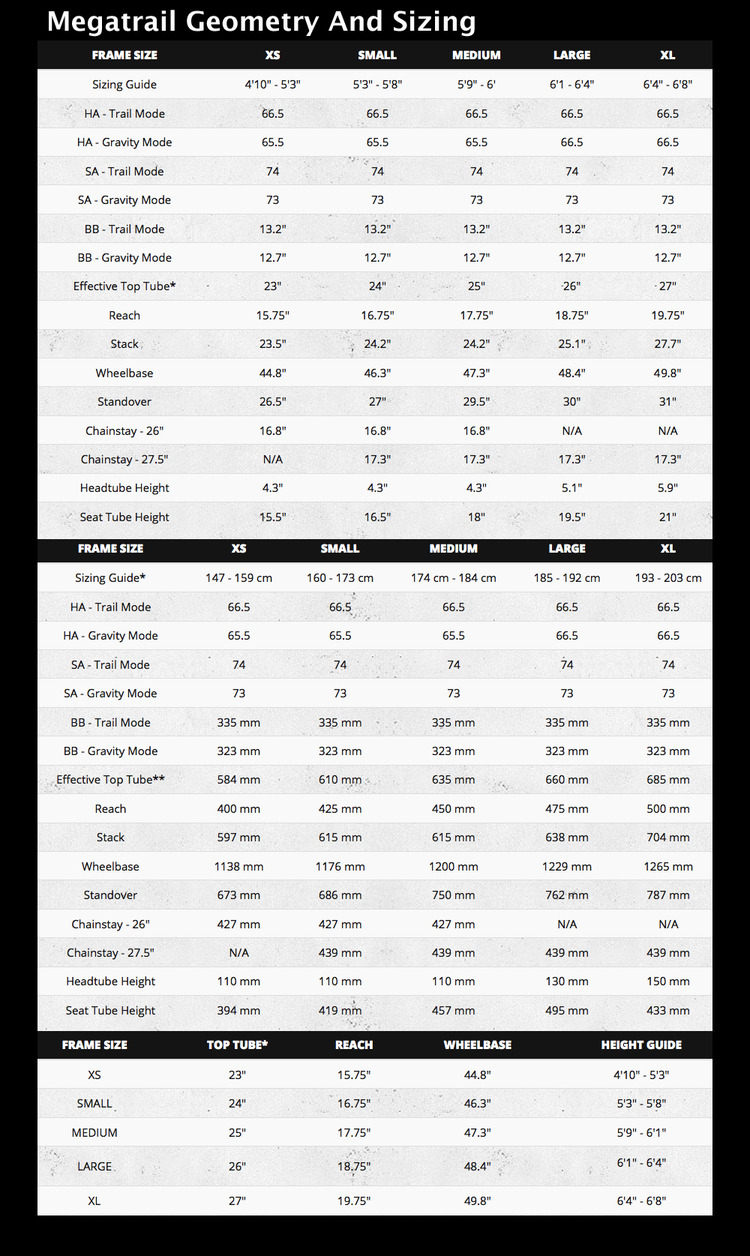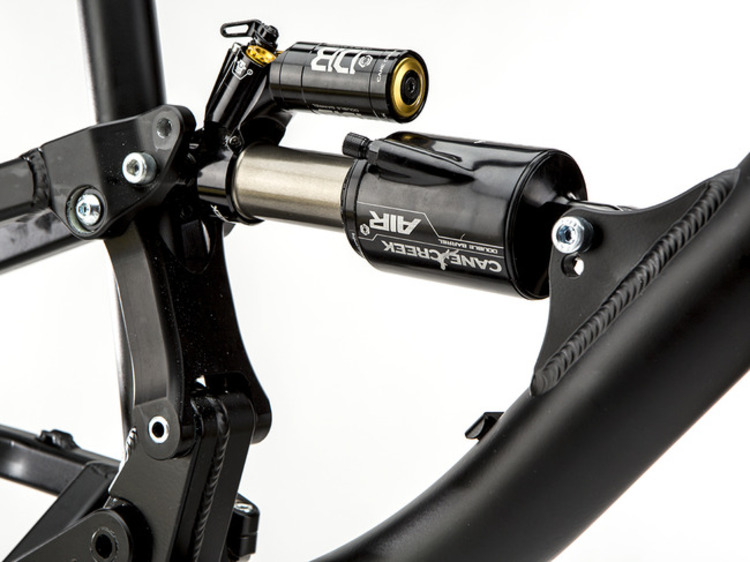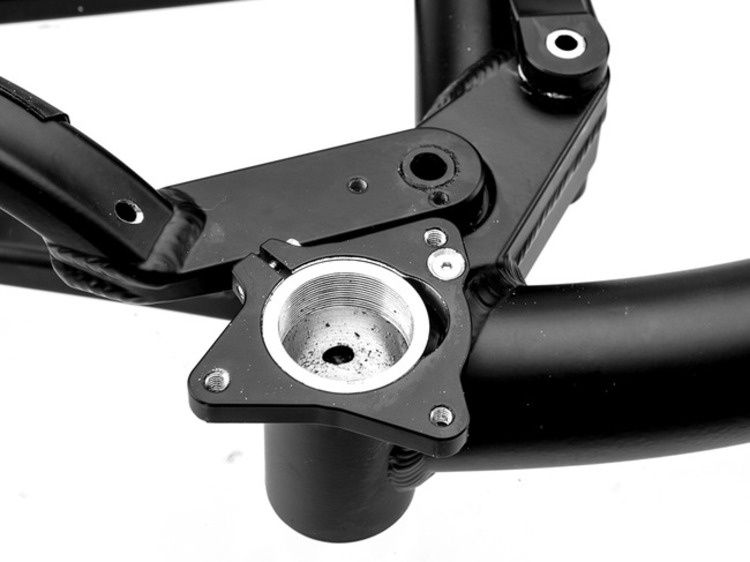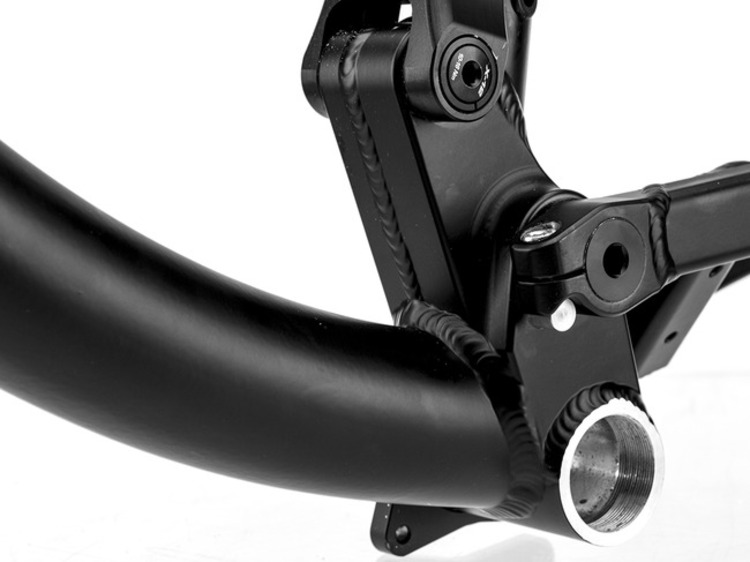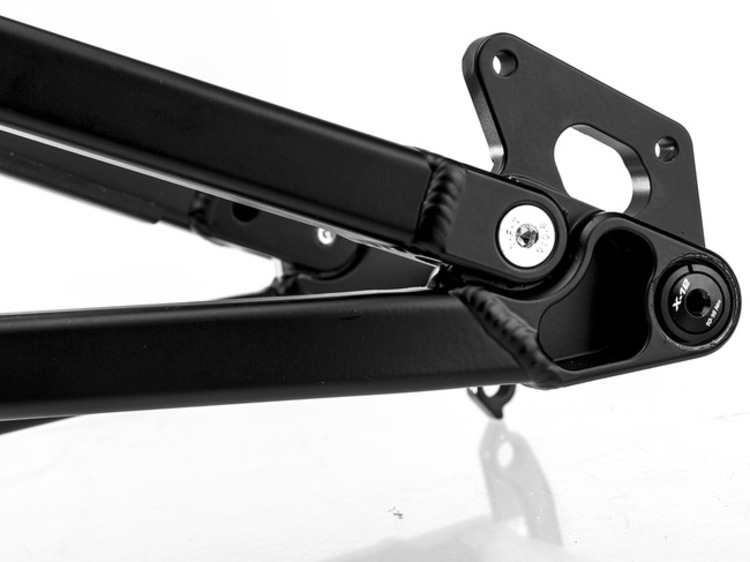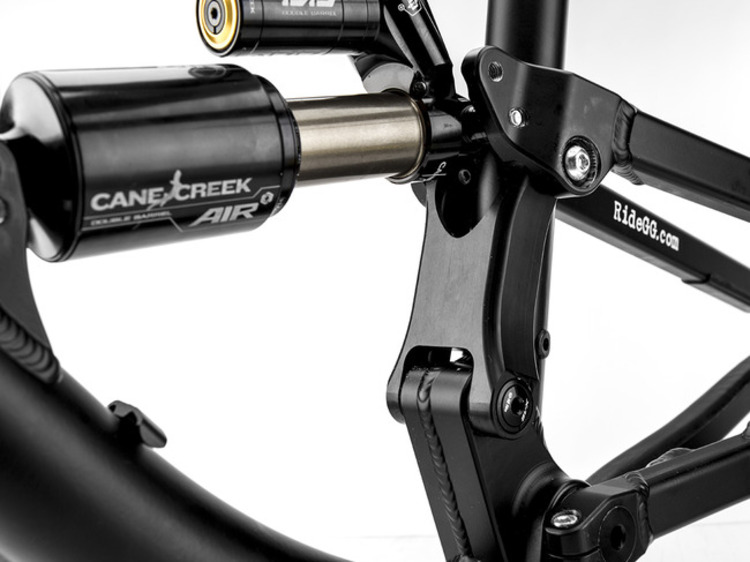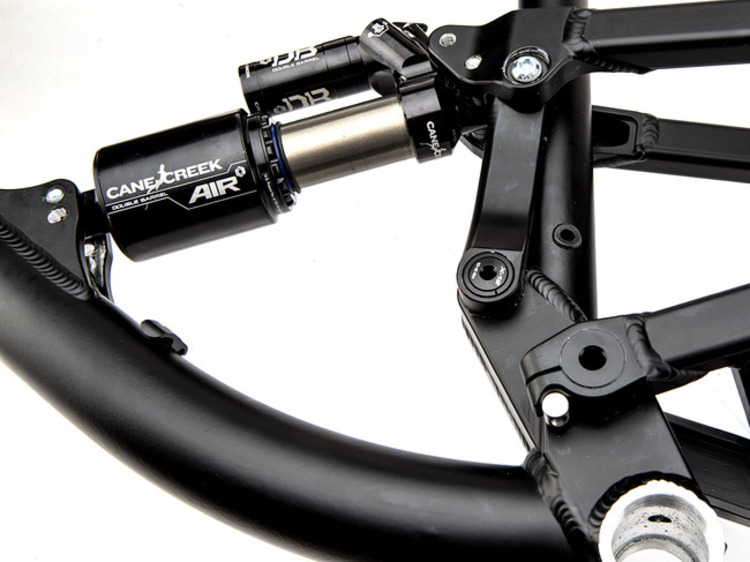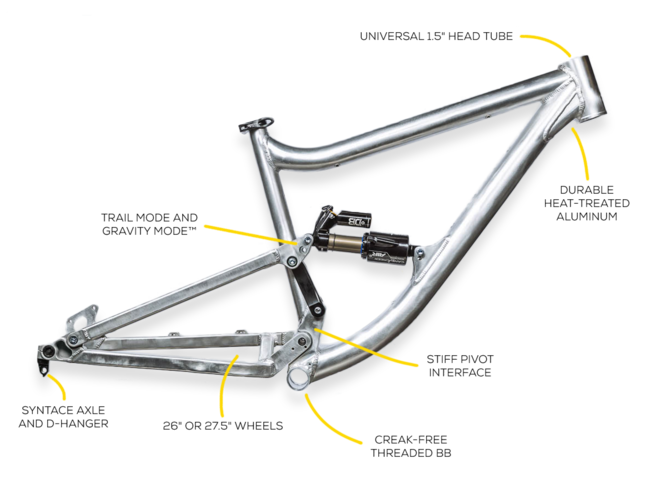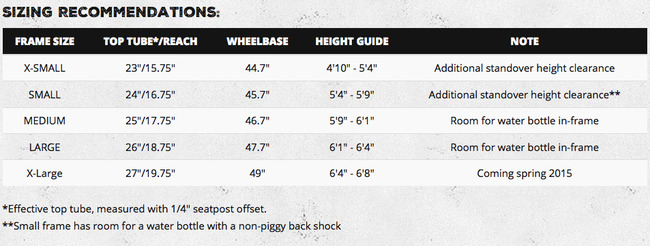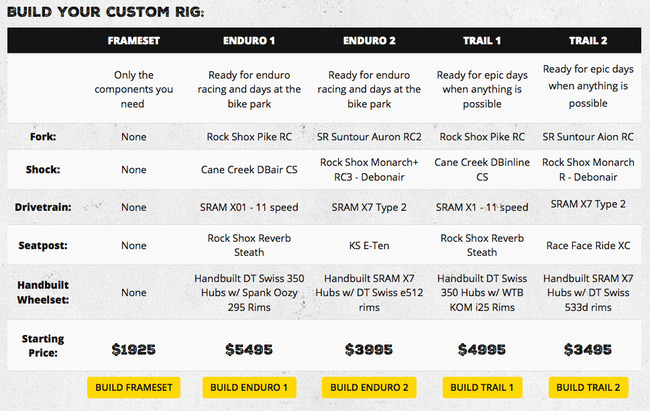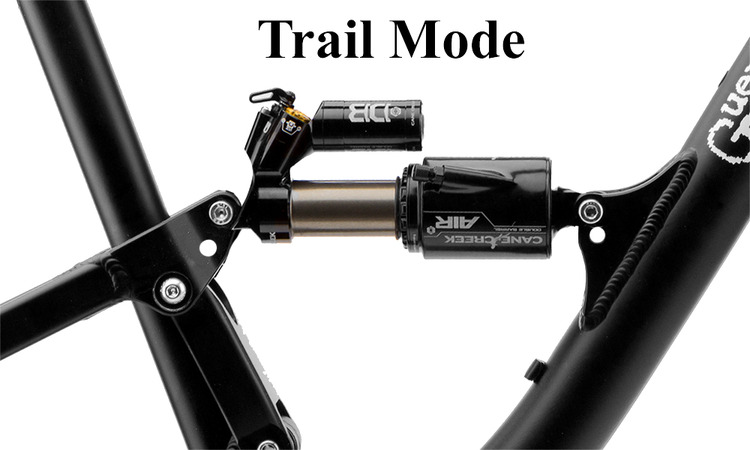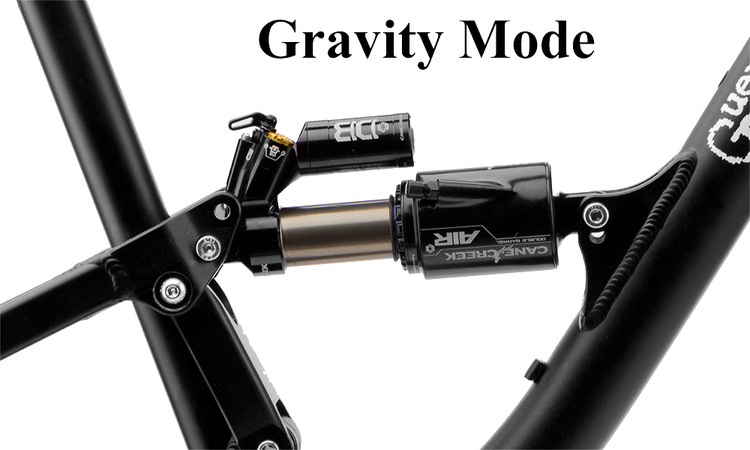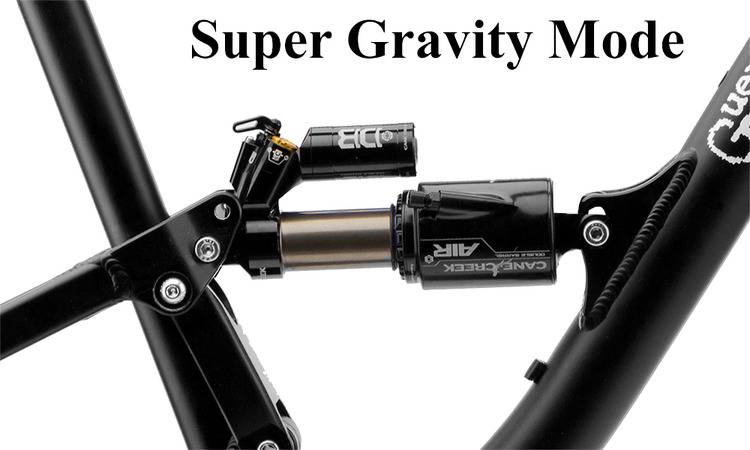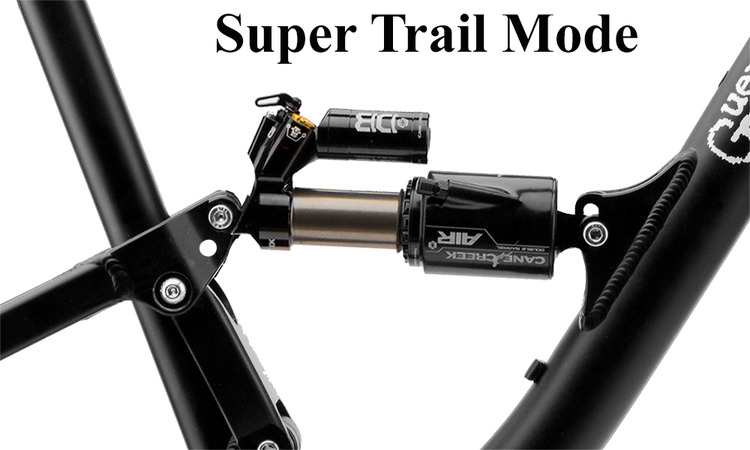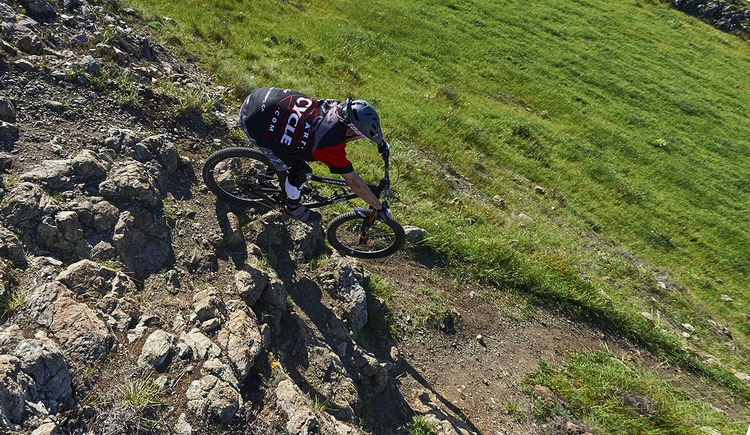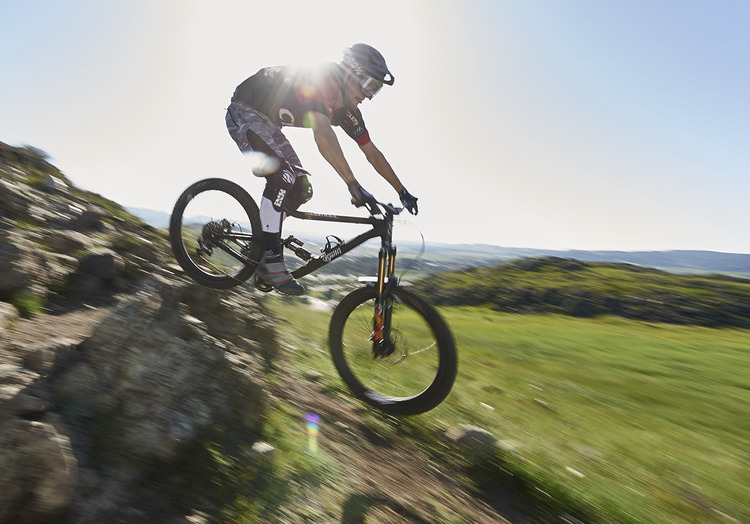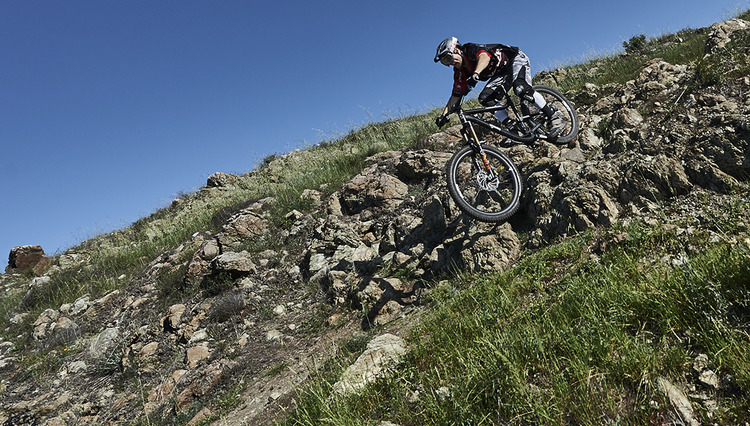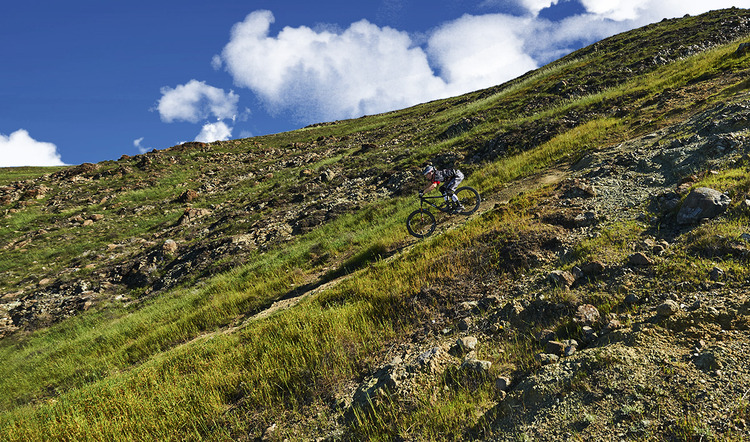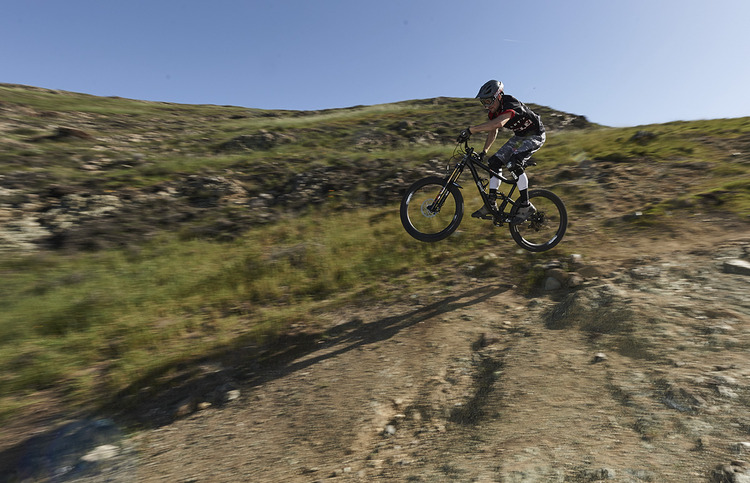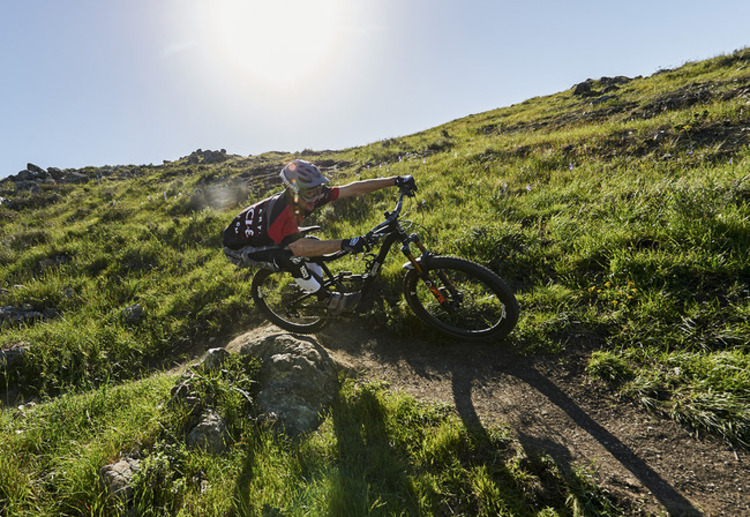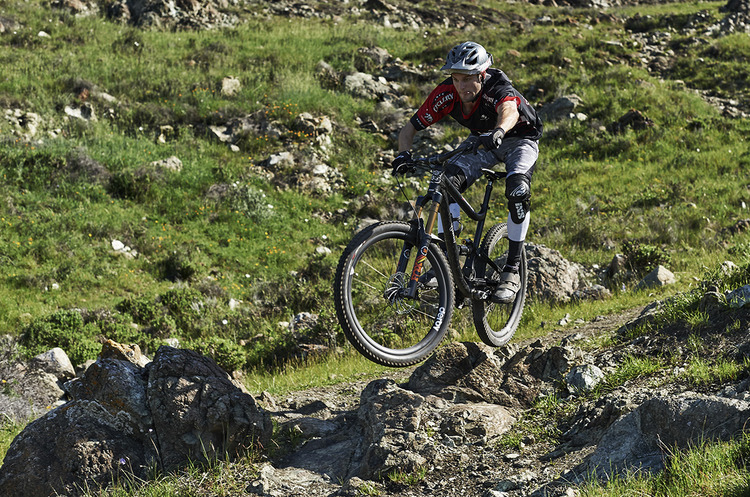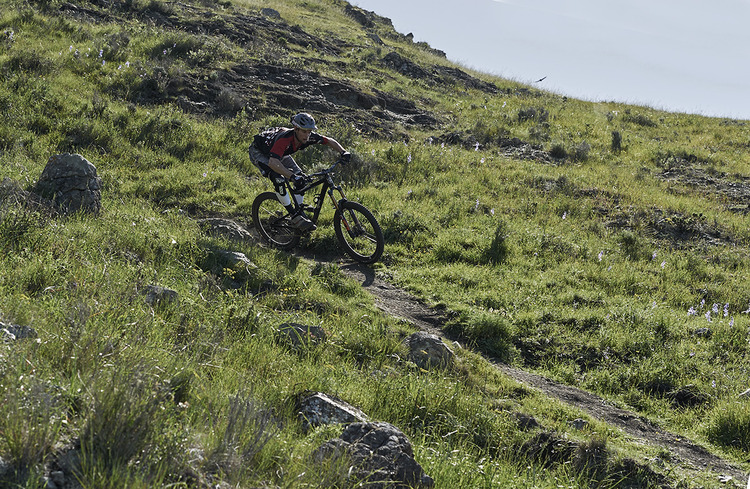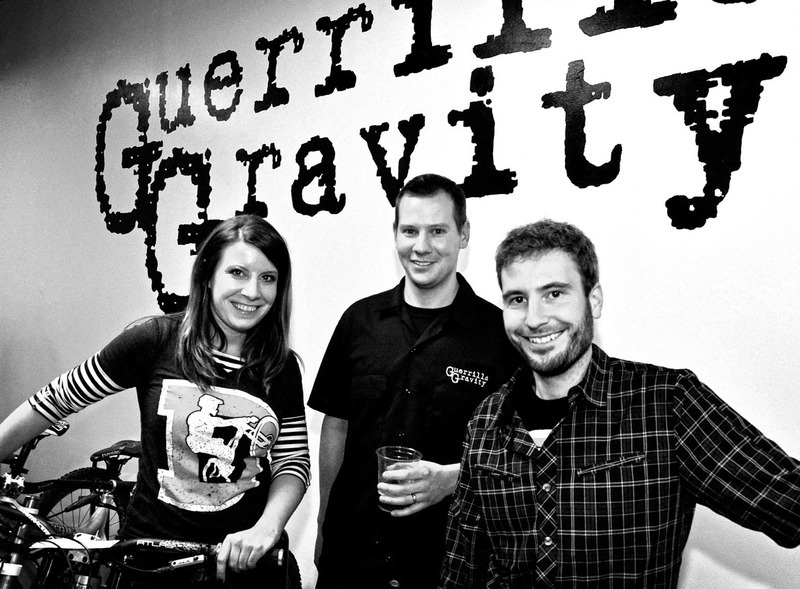Guerrilla Gravity Megatrail Review
 Saturday, February 28, 2015 at 12:00AM
Saturday, February 28, 2015 at 12:00AM  Permalink
Permalink
Guerrilla Gravity is a small mountain bike company located in Denver Colorado. They were sick of frame prices shooting through the roof while production moved overseas with little, if any, performance increase from year to year. All this while many bike companies grew in size and became more distant from their customers and what they really wanted in geometry and suspension designs. Who wants to buy a frame for $3500 and have part of it go to subsidize some road racers salary anyhow?
"The MEGATRAIL is leading the revolution in trail bike freedom.
As a highly refined and extremely versatile trail bike, the MEGATRAIL is built for everything from conquering high-alpine adventures to getting after it at your local enduro race,or just slaying your after-work rides. And when it’s time to turn the Rad up to 11, Gravity Mode™ provides a 30-second, one-bolt geometry toggle that transforms the bike into a downhill dominator.
The MEGATRAIL isn’t purely focused on downhill domination, though. Extremely well-tuned anti-squat characteristics and mid-stroke support create a very efficient pedalling platform.
The modern geometry utilizes a roomy cockpit designed for short stems and wide bars, with slack head angle and low bottom bracket. Both front and rear frame triangles are optimized for each specific wheelsize (26" or 27.5"), giving you the choice to run whatever you want; 27.5" front/26" rear is also possible. Building on the lively ride qualities of the GG/DH downhill frame, this design achieves best-in-class pedaling, next-level cornering, and downhill authority. The MEGATRAIL suspension was developed in collaboration with Cane Creek for the DBair CS. It's optimized for air shocks and provides support while pedaling, small bump sensitivity, and progression for hard bottom-out resistance.
Geometry Benefits
- Security in steep areas
The front axle is more advanced than in a conventional geometry making it almost impossible to go over the bars in steep sections. It feels more secure and confident due to a slacker angle perception.
- Confidence at high speed
The longer wheelbase makes the bike much more stable over any terrain.
- Direct steering
The really short 10 mm, 30 mm or 50 mm stems mean much less handlebar movement to get the same front wheel angle, thus improving steering precision and making the bike extremely reactive.
- Uphill precision
The front wheel keeps the contact on the ground avoiding wheelies due the longer front-center length.
- Stability on rough sections
The FG defends a new weight balance between front and rear wheels making possible to load the front wheel a lot more than with a classic geometry. This possibility changes your handling as it allows for more grip in cornering and better control."
Guerrilla gravity Megatrail Geometry And Sizing
We ordered the Megatrail in a size LG. This was right on the edge of what our 6 foot test riders could ride. The bike is huge and a large will fit someone up to 6' 4" tall. They will be offering an XL in very short order as well. No bike comes close so if you are near 6'8" this would be the frame you should look at. Having such a long TT we opted for a 35mm stem and it ending up working very well. The bike has a threaded BB (thank you) because nobody needs to hear random noises so a manufacturer can save some cash on build costs. They also have the ability to run a stealth post or by using the clamps on the TT a standard dropper post can be used. It also has a 1.5 HT, 142 by 12mm rear axle and the post size is 30.9 as well. Our LG frame had room for a larger water bottle. Guerrilla states that the small sized Megatrail will accept a water bottle under the top tube only if using a non piggy back shock.
Assembly was a snap with no issues. Everything went together as it should. We ordered our Megatrail with the ISCG05 chain guide adapter the frames shipping now include them. It clamps down onto the BB shell. So our bike is very much on the gravity side as far as a build goes. We are running SRAM X01 11 spd, Derby 40mm DH hoops laced to Profile Elite hubs. We have Specialized Grid 2Bliss tires F/R on the bike. We used Race Face SIXC parts. The BB in gravity mode is 12.7" high! We got 175mm arms and now realize we should have waited for the 170mm to come into stock. They scrape sometimes on the way up as well as on the descents if you are not being careful. For a fork we are now using the Fox 36 Talas Float. The frame, wheel combo are so stiff that we decided that having a front fork act as a noodle on the rougher stuff was not a good idea.
Our large frame weighed just over 8LBS with a CCDB Air CS shock. The tubing they use is the same wall thickness as their DH bike. You know this will be a durable frame, combine that with its oversized tubes and giant bearings and you are left with one of the stiffest chassis in the MTB game. Not only that but it is made to be abused. This isn't an Enduro or Freeride bike for the 40 year old XC rider. This is an Enduro bike for the gravity racer meant to be hammered on and ridden on rough terrain and at bike parks. The Megatrail is the Downhiller's Trail Bike!
The Megatral has very aggressive geometry in Gravity Mode with a 65.5 HA, 12.7" BB and a wheelbase that is almost 48.5" in length, it rewards those that carry speed and ride on the edge. But it can also save your bacon and make a ride that many call rough on a standard trail bike seems much smoother. It rides a fair bit like a DH bike and requires some front weighting in corners at times.
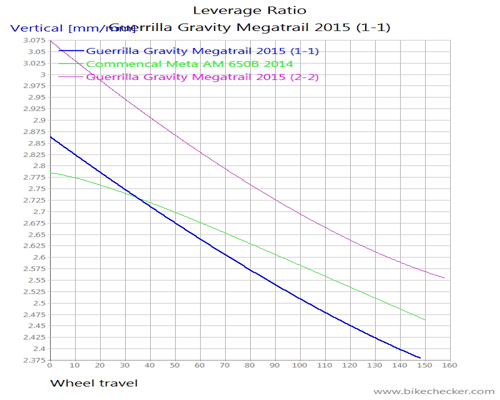
Frame Features
- Trail Mode and Gravity Mode™
- Optimized for 26" or 27.5" wheel options
- Chainstay length for 26": 16.8"
- Chainstay length for 27.5": 17.3"
- 1.5" head tube (49 SHIS) is compatible with all steerer tubes and Cane Creek Angleset
- Optional, replaceable ISCG05 chainguide mount
- Universal Syntace rear axle and derailleur hanger
- Premium Enduro Maxx cartridge bearings last longer (they have more balls)
- Threaded bottom bracket greatly reduces creaking and loosening (vs press fit)
- Stealth cable routing for adjustable-height seatpost
- 7 lbs. (3,175g) frame with hardware (size Medium, no shock)
Frames Specs
- 30.9mm seatpost (34.9mm clamp)
- 142 mm rear wheel spacing
- 73 mm BB spacing
- 200x57 mm shock
"Gravity Mode
Head angle: 65.5°Rear Travel: 160mm
BB Height: 12.7"
Suspension platform: grip & rip
Leverage curve is tuned for more bump compliance and grip... all out ripping. This mode was developed to feel like a mini-DH bike that can still pedal. Bottom bracket height is set to the same sagged height as the GG/DH, along with the leverage curve tuned to feel like a shorter travel GG/DH.
Trail Mode
Head Angle: 66.5°
Rear Travel: 150mm
BB Height: 13.2"
Suspension Platform: pedal & pop
Leverage curve is tuned with more mid-stroke support for increased pedaling performance, creating an amazingly efficient platform. Want the poppy suspension platform of Trail Mode, but the geometry and travel of Gravity Mode? SUPER GRAVITY mode is accessed by putting the shock in both lower mount holes.
Megatrail Owner Info
Megatrail Setup
Suspension Setup
Proper suspension set-up is critical for optimum performance. Due to variance in shock pump readings, we suggest using a ruler and a friend to help set sag.
Recommended front fork sag is 15%. Recommended shock sag is 13 mm for a healthy mix or Trail and Gravity Mode™, 14 mm for mostly Trail Mode riding, and 12 mm for mostly Gravity Mode™ riding.
To set sag:
- Step 1: Compress the suspension several times to break the seal and get oil flowing
- Step 2: Have a friend hold the bike while you sit on it in the climbing position, both feet on the pedals
- Step 3: Have said friend move the fork o-ring down to the seal and the shock o-ring to the front of the air can
- Step 4: Gently step off the bike and measure the distance between the o-ring and the seal and air can. This is your sag
- Step 5: Adjust the air pressure using your shock pump to achieve the recommended sag setting (listed above). It may take a few times.
Shock specific setup info:
- Cane Creek DBair CS: Cane Creek shocks purchased with a frame come preset with the base tune--you just need to set sag and tweak the damping settings to your weight, with gear weight taken into account. The base tune is dialed in for a rider weight of 175 lbs (find the base tune here). Adjust +/- 2 clicks of low speed settings and 1/4 turn of high speed settings for every 20 lb increment of rider weight difference from 175 lbs. Email us to talk further about shock settings for your unique riding style and terrain.
- Cane Creek DBinline CS: Cane Creek shocks purchased with a frame come preset with the base tune--you just need to set sag and tweak the damping settings to your weight, with gear weight taken into account. The base tune is dialed in for a rider weight of 175 lbs (find the base tune here). Adjust +/- 2 clicks of low speed settings and 1/4 turn of high speed settings for every 20 lb increment of rider weight difference from 175 lbs. Email us to talk further about shock settings for your unique riding style and terrain.
Note: This shock is not recommended for riders heavier than 220 lbs. - Rock Shox Monarch Plus RC3 - Debonair: This shock has three compression settings. The Mid setting is great for more general climbing and descending. The Soft setting is ideal for chunky, but not high speed trails. The Hard setting is ideal for smooth climbs.
- Rock Shox Monarch R - Debonair: This shock does not have compression adjustments, you just need to set sag and ensure rebound adjustment provides fast enough rebound to not pack up, while not feeling "bucky."
- Trail Mode: Both top shock mount positions
- Gravity Mode™: The lower rear mount and upper front mount
- Super Gravity: Both lower shock mount positions
- Super Trail: The top rear shock mount and lower front shock mount
- A note about tightening and loosening the bolts: It is recommended that you loosen both shock bolts when installing or changing the modes. Do not tighten the shock mount bolts beyond the hard bottom out. Over tightening will result in a bad time."
- Trail Mode: All mountain geometry with more mid-stroke support that provides a very efficient pedaling platform with a slightly taller BB setting. This mode is ideal for sustained climbing, technical climbing, and all-around descending.
- Gravtiy Mode™: More aggressive, DH-inspired geometry and suspension feel, with a softer mid-stroke that is best suited for downhill domination. The pedaling platform is still perfectly adequate for mild climbs, such as fire roads.
- Super Gravity: The geometry and travel of Gravity Mode™ with the leverage curve of Trail Mode. This mode is designed for going mach-stupid, carrying speed over the rough and hitting big jumps.
- Super Trail: The geometry and travel of Trail Mode with an extra stiff mid-stroke and a lot of progression. This mode would be best for long, smooth climbs or pedal sections."
Having four different modes to choose from on the bike can seem like overkill but trust us it surely is not. These modes alter the way the bike rides in very dramatic fashion. The rear hole affects the Geometry and travel of the bike; the low hole is Gravity Mode and top hole is Trail Mode. Up front there are also two holes, the top hole offers a more linear shock rate while the bottom adds mid stroke shock support and boosts the bikes pedaling ability and makes it more lively. This is especially noticeable in Gravity Mode! Although the bike is geared towards the more aggressive rider it's pedaling ability is outstanding and many claim it is one of the best 6" bikes out there for climbing!
Trail Mode on the Megatrail offers a 150mm bike with a 66.5 degree HA and a BB height of 13.2". This works wonderfully for many trails. It provides a good platform to pedal from. The bike transfers power to the rear wheel without much in the way of bob. Typically on climbs we would use the CS feature on the CCDB Air shock. This makes the bike a very efficient climber. Descending in trail mode the bike is very lively and makes line changing a snap. The suspension does well at eating up the small bumps and when bigger hits come along it handles those with ease. Riding the bike in this mode will work well for most trails but when the rocks get big, shoots become steep and the speed levels increase the Megatrail can offer the rider Gravity Mode.
Gravity Mode on the Megatrail gives 160mm of travel with a 65.5 degree HA and a 12.7" BB. This mode gives you a very capable trail bike. It rides very much like a Downhill bike in this setting. Everything slows down, the bike moves just a hair slower as the rate of speed increases. It does its best to stay glued to the ground and offers increased traction over Trail Mode. The lower BB gives the bike incredible stability at speeds and makes high speed turns just that much easier. It doesn't have the increased pedal platform like Trail Mode does and this can be obvious when climbing or hard sprinting. It bobs a bit more but the suspension itself is more forgiving and linear in nature. Sometimes a rider may want the lower/slacker geometry offered by Gravity Mode but with a more lively feel that is where Super Gravity Mode comes in.
Super Gravity Mode was used a bunch on some of the faster rockier trails in our area. It made the bike pop off obstacles more and made getting airborne that much easier. It also alters the bikes leverage curve and makes it the same as Trail Mode so the bike pedals better as well. It becomes apparent on the rockier terrain that the Super Gravity mode offers a much more lively feel. Popping off jump faces in this mode gives the hack in us that little bit of extra boost to help clear sections. Riding a trail like A-Line in Whistler would be the perfect spot for the Megatrail to be used in Super Gravity. Sometimes there is a climb ahead that is brutally long and gains massive amounts of elevation. In that instance the Megatrail has fourth mode called Super Trail.
Super Trail Mode on the bike offers a very stiff leverage curve on the shock. You can tell when you hit rocks on the way up. This mode is great for long drawn out climbs that are smooth. Using the Climb Switch in Super Trail Mode the shock literally has no bob even when making strong strokes to clears obstacles. We only used this a small number of times since most of the climbs in the area are pretty rocky.
Guerrilla Gravity has basically created a 4 in 1 bike with the Megatrail. The differences between each mode is very dramatic. In Gravity setting the bike is as close to a Downhill bike as you can get with an Enduro machine. The Trail Mode makes it a very capable climber that can keep up with the best of them. Being able to alter the frames leverage curve gives the ability to alter the two distinct geometry settings to match the trail. Whether the rider is looking for better pedaling characteristics of more traction the Megatrail has both covered with the changing of a bolt.
The ride the Megatrail offers is stiff! We have ridden many Downhill bikes in the past and a fair number of trail bikes. About the only bike we can think of that felt this stiff was an Evil Imperial! Essentially there is no detectable give in the frame under hard cornering or braking. They actually use the same gauge tubing on the Megatrail as they do on their Downhill bike. Having such a rigid chassis will transmit a bit more trail into the handlebars than a more forgiving chassis. Another thing very much worth noting about the frame was their decision to use a threaded BB and a 1.5 steer tube. Thanks GG for making our bike assembly easier and also helping to keep it quite for a very long time. Looking at the bike and its use of large bearings, high grade hardware, and avoiding the latest in cycling standards it becomes apparent it was designed with the input of experienced mechanics.
Ian W
Guerilla Gravity has certainly succeed in creating a Downhillers trail bike with the Megatrail. This bike is very capable at descending steep and rough terrain. It's something all the manufactures claimed to have achieved but after you spend some saddle time on many of their bikes it becomes apparent that their target market is former XC riders, Dentists or Attorneys. Its seems as if GG came at it from the Gravity side and it shows when riding the Megatrail.
The bike does many things well. It is very stable at speed having such a long WB and low BB the bike is very much like a Downhill bike in this regard. The traction it offers in Gravity mode is also very good. This setting makers the bike track the ground and hover atop the rocks and chunder. If that isn't lively enough throw it into Super Gravity and pop off the rocks instead. Having so many variants in one bike is a great feature. They all work well and do truly turn it from a Enduro bike into a mini Downhill bike.
Guerrilla Gravity delivered a very high quality frame. That is the nice thing about aluminum you can see the welds and any issues or mistakes made by the welder. Something plastic bike owners don't get the benefit of these days. Their use of sensible standards make for a solid build on the frame with little trouble. We did have one small issue where the rear wheel rubbed a few times on the rear stay on the bikes left side. We ran 2.3-2.4 tires from both Specialized and Geax. It didn't happen often in the 5 months of riding,
Overall the Megatrail is a confidence inspiring Trail bike that is built like and rides like a Downhill bike. This is a trail bike that can last for years of trail riding without issue. Having a bike that lasts more than a few seasons under serious riding is a rarity these days. If you are looking for a park capable trail bike that you can ride just about anywhere that will stand the test of time and not hold you back in anyway the Megatrail is a bike you should take a serious look at. We would gladly recommend the Guerilla Gravity Megatrail to a friend it has been a blast to ride.
Guerrilla Gravity Megatrail Questions
3. Break down your team for us and what they do?
4. How did the idea for the Megatrail begin?
5. What where some of the main features you guys wanted in the Megatrail when you were laying it out on paper (computer)?
6. How was reception been on the Megatrail so far?
7. Do you weep when you see guys that are 6' 4” and above on a “XL” bike and they look like Spud Webb on a 16” BMX bike?
8. It sounds like you guys are going to be doing an XL frame soon. Tell us a bit about the new frame size?
On top of that, we can do semi-custom sizing for riders who may be proportioned slightly different (e.g. long legs, shorter torse).
9. Any updates you guys are looking to do to the Megatrail in the near future?
10. Care to elaborate on Geometry used on the Megatrail?
11. Rocks or jumps? How about jumps in rocks?
12. Who is the best Mountain Biker ever?
13. What do you think about all the new standards that have popped up in the last 3 years?
14. What would make the bike industry better?
15. Anything else you want to get across to the readers?
Thanks
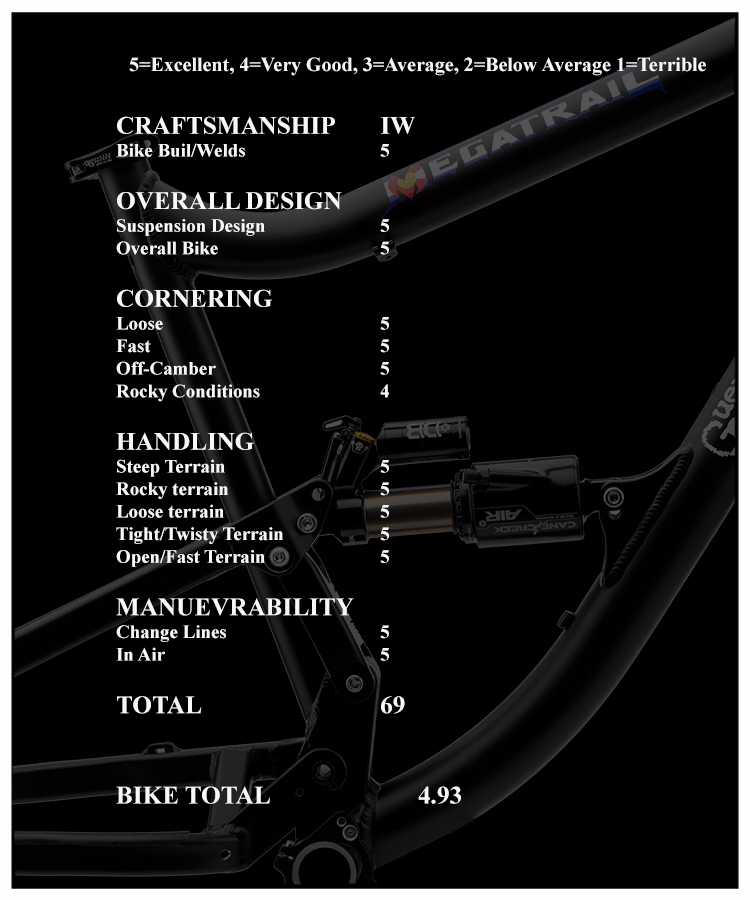
Guerrilla Gravity releases the MEGATRAIL, the Big Mountain Liberator.
Highlighting the Guerrilla Gravity Megatrail.
Megatrail Owner's Manual





